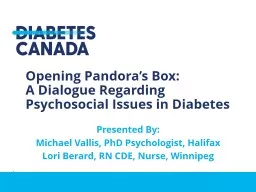PPT-Opening Pandora’s Box:
Author : pasty-toler | Published Date : 2019-02-24
A Dialogue Regarding Psychosocial Issues in Diabetes Presented By Michael Vallis PhD Psychologist Halifax Lori Berard RN CDE Nurse Winnipeg Unrestricted education
Presentation Embed Code
Download Presentation
Download Presentation The PPT/PDF document "Opening Pandora’s Box:" is the property of its rightful owner. Permission is granted to download and print the materials on this website for personal, non-commercial use only, and to display it on your personal computer provided you do not modify the materials and that you retain all copyright notices contained in the materials. By downloading content from our website, you accept the terms of this agreement.
Opening Pandora’s Box:: Transcript
Download Rules Of Document
"Opening Pandora’s Box:"The content belongs to its owner. You may download and print it for personal use, without modification, and keep all copyright notices. By downloading, you agree to these terms.
Related Documents














